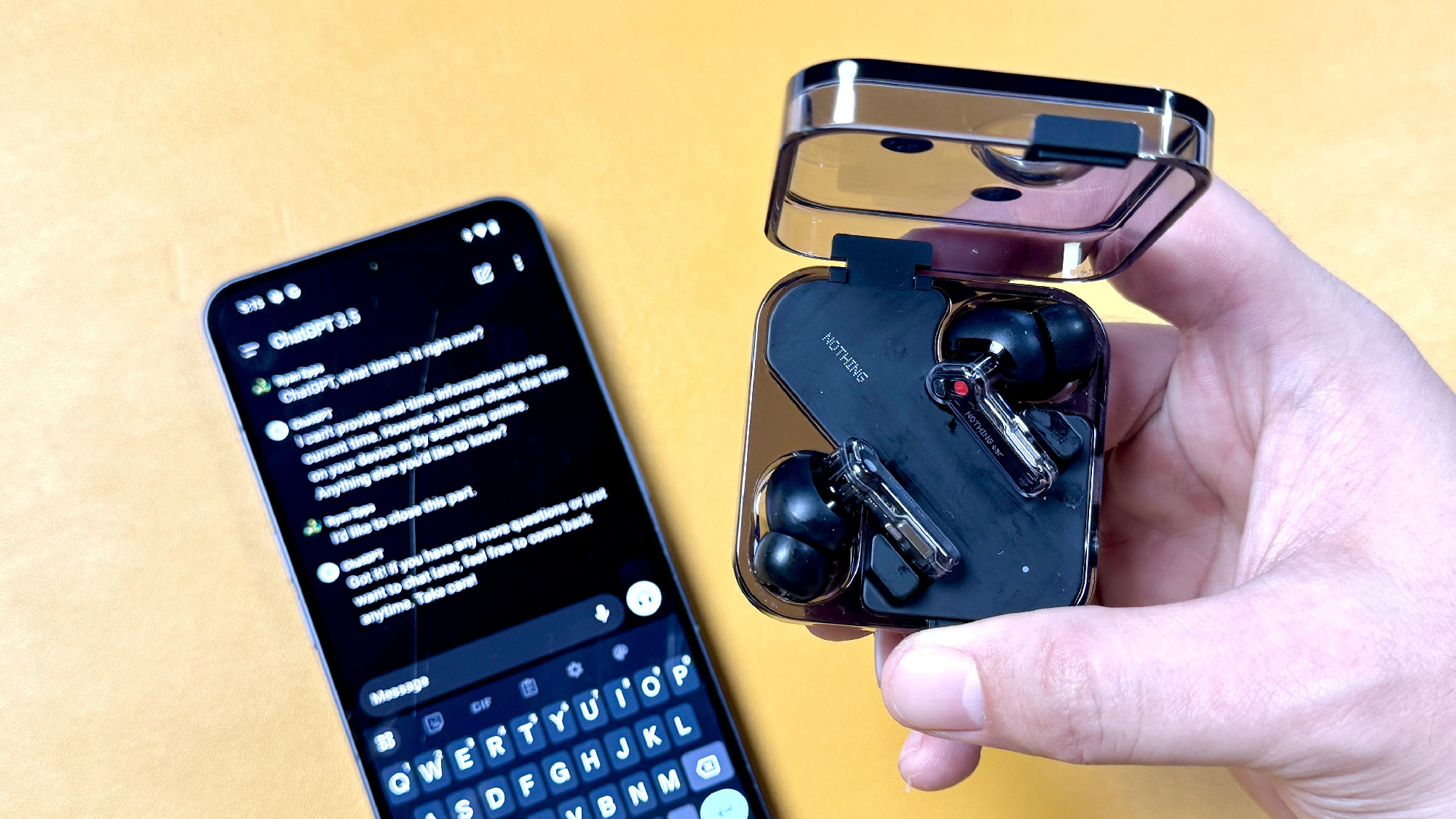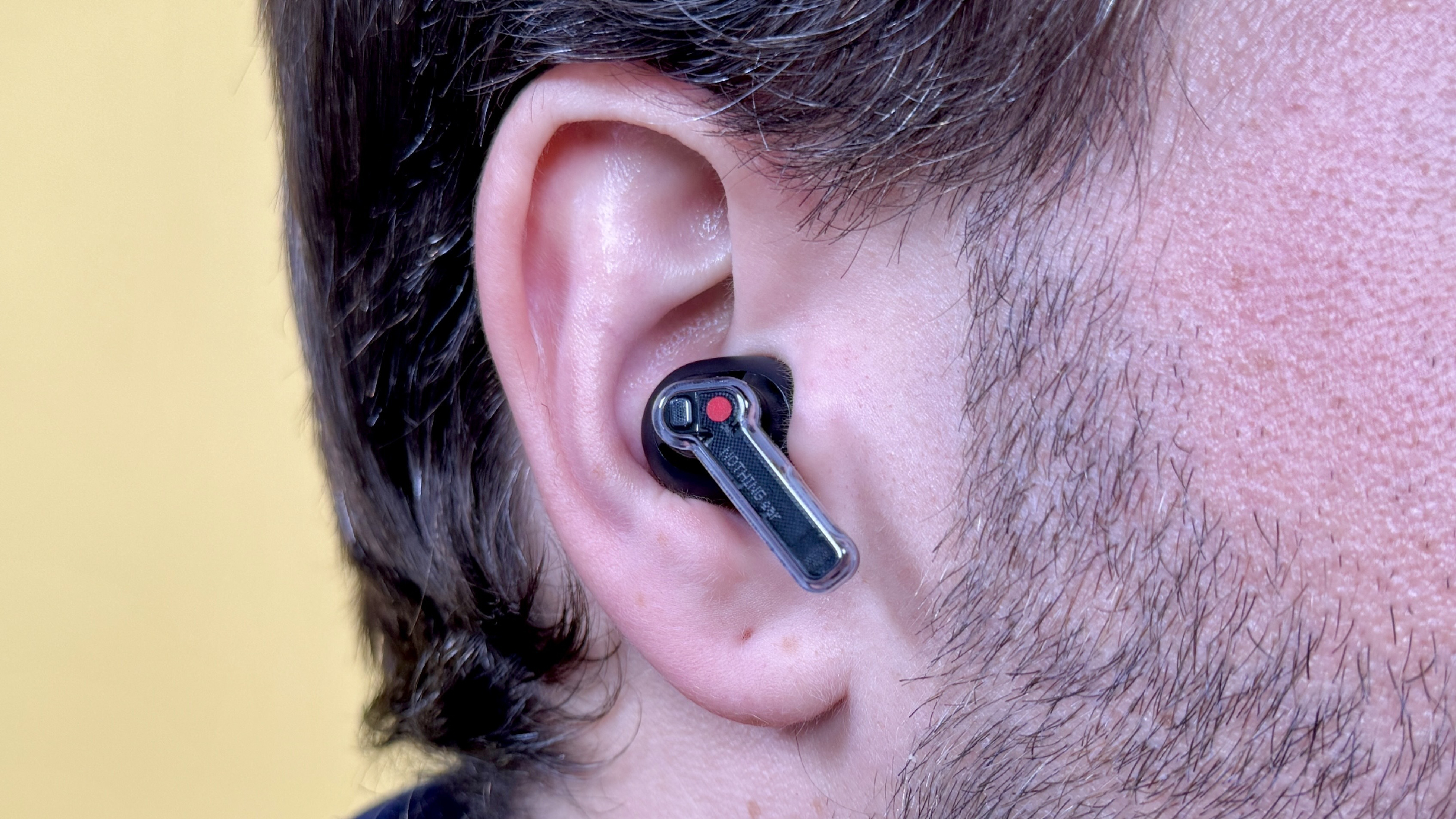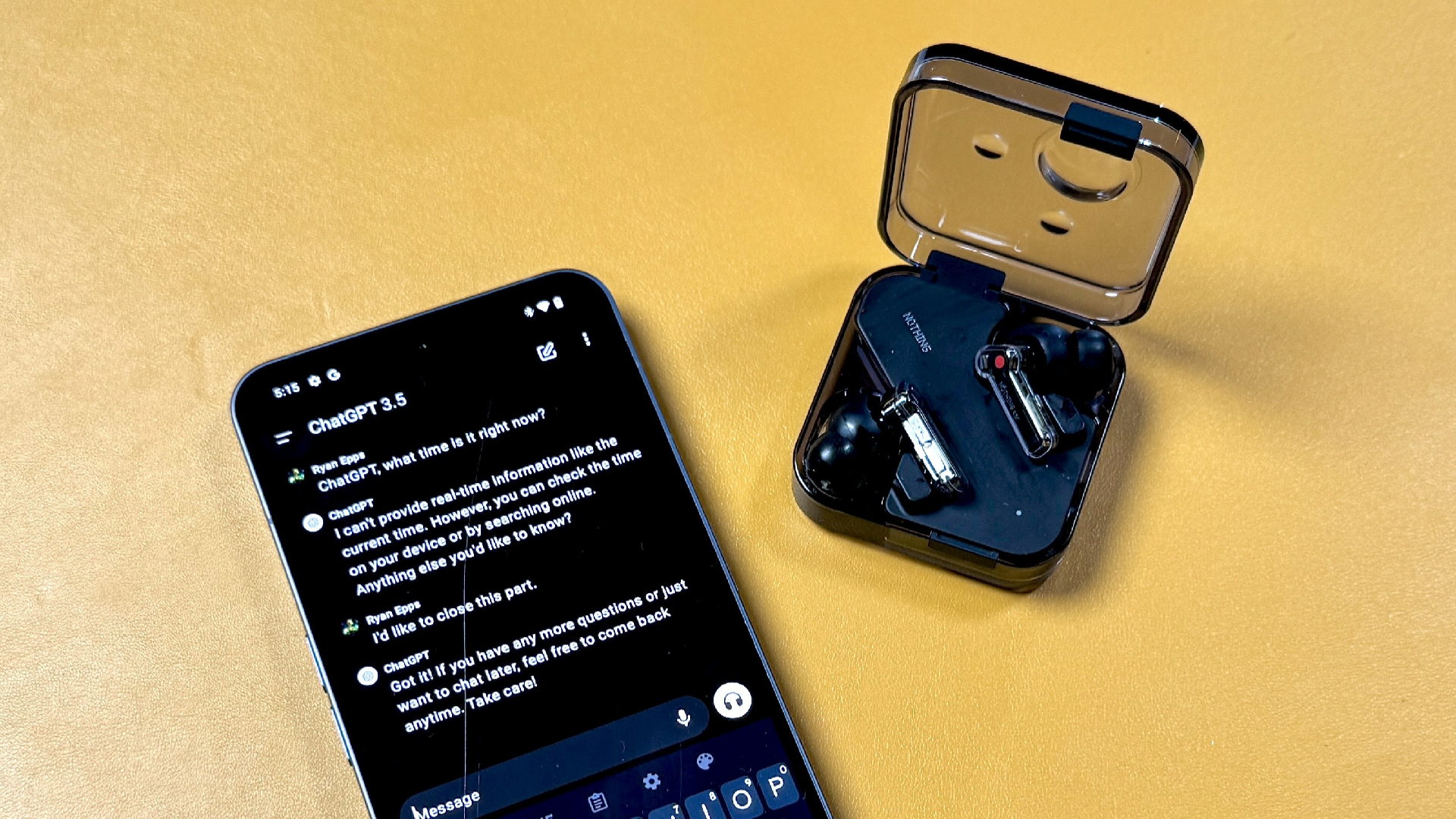
Following the launch of its new Nothing Ear and Nothing Ear (a), Nothing announced a new integration with OpenAI’s ChatGPT that allows you to seamlessly talk with everybody’s favorite large language AI model.
As of yet, this feature is relegated to the newest Nothing Phone (2) following a firmware update to the 2.5.5 release, but is set to make its way onto the Nothing Phone (1) and Nothing Phone 2a by late April. It will also release on other Nothing audio products in June, so if you’ve got the Nothing Ear Stick and were hoping to talk to ChatGPT, don’t fret.
I’ve been testing Nothing’s new ChatGPT integration to see if the beloved AI chatbot can truly make a difference in my life when always in-ear. It’s been quite an interesting few days and there’s a lot to be said about having an LLM in your ears 24/7 — but sometimes they don't work as intended.
Endless possibilities with ChatGPT
So, how does this work exactly? Setting up ChatGPT with the Nothing Ear is super simple: You’ll need ChatGPT installed on the device, plus the latest Nothing OS firmware. Once your Nothing Ear is paired to the Nothing Phone (2), you’ll get an alert on the Nothing X app to activate the ChatGPT integration.
To use ChatGPT you “pinch and hold” the earbuds (the only control option right now) but it can be applied to either the right or left earbud, it doesn’t matter. It also requires an internet connection to function, but that shouldn't be an issue for those with the Nothing Phone (2) as their main device — though, it is worth noting if you’re in an area with limited reception.
With all of this set, you’re now free to ask ChatGPT practically anything by simply pressing down on your earbuds. It’s literally that simple.

Surprisingly? It works quite well, too. I tested the integration in several different environments, including at home in my apartment, the office and out on a stroll.
You can ask ChatGPT to give you directions back home, but you will have to tell it where exactly you are — it can’t access your current location using your phone, which is slightly annoying. Still, following ChatGPT's spoken instructions was quite hilarious, totally scary and, to some degree, revolutionary.
When I provided ChatGPT my location, getting nearby recommendations was surprisingly simple. I asked it where the closest bar to me was, and it gave me one in an instant. I also asked for several dry cleaners in the area and it gave me a total of three, all with full addresses. Voiced location services and mapping seem like they could be the biggest draw behind this integration, but even those are merely scratching the surface of what's possible.
The bigger picture

I wanted to really push the limits of ChatGPT in my ear. I asked it a smattering of harder, complex queries, like explaining the ongoing TikTok ban fiasco in the US. Unfortunately, ChatGPT is limited in its information-gathering, explaining to me, “As of my last update in January 2022, TikTok is still operational in many countries, including the United States.”
Thus, it didn’t have up-to-date information that, earlier that very same day, US President Joe Biden signed a bill requiring ByteDance to divest the company. Similarly, I asked what was going on with Drake and Kendirck Lamar, and it told me, “There hasn’t been any recent notable public feud or collaboration between Drake and Kendrick Lamar,” despite the fact that it’s a major on-going conversation in the hip-hop world.
Another inquiry I threw its way was in asking who might win the ongoing Vancouver Canucks vs Nashville Predators NHL series. Both teams are tied 1-1, and I wondered if the Preds could really pull out a win on Friday, April 26. Of course, ChatGPT gave reasons as to why both outcomes have equal potential, but having that possibility of asking an AI in my ear what could happen was truly fascinating — if only slightly limited.
Though I didn't use any of them, I even asked ChatGPT for potential headlines for this very article. Those included:
- ChatGPT Unplugged: Exploring the World of Conversational AI with Nothing Ear
- A Sound Experience: ChatGPT Dives into the Digital Realm with Nothing Ear Earphones
- ChatGPT Goes Wireless: A Hands-Free Journey with Nothing Ear Headphones.
While limited in its reach, it’s still something to experience.
I did all of this without ever picking up or opening the Nothing Phone (2). I simply pinched, asked questions into my earbuds and was given these varied responses on the fly. While limited in its reach, it’s still something to experience.
Nothing still has some limitations

The integration of ChatGPT on your phone might one day spell the end-all, be-all of hands-free assisted functionality — but that's not really the case here. For starters, ChatGPT doesn’t have basic capabilities that both Google Assistant and Siri have, like calling someone from your contacts, setting alarms, or even playing music.
Additionally, ChatGPT cannot access real-time data. This means that answers to particular queries might be misinformed to some degree, like local traffic or sports game scores. You can ask it what games might be playing that day and what traffic might look like at a particular time, but you won't always get the best answer and specificity is of utmost importance. ChatGPT will also constantly ask for additional information to nail down a proper answer to your question, and I wish it was just a bit more intuitive and didn't need as much input from the user.
This form factor might well spell the future of this technology, but as of yet it’s still very early stage, of course, and there's a lot that needs to be addressed, namely interoperability, real-time information gathering, and improved intuitiveness.
I also found that some searches tended to be somewhat slow. This could be due to a poor internet connection, or it could be the complexity of the search query itself. For instance, I asked ChatGPT for information on flights to Japan. After giving it my particular dates and airline preferences, it told me to wait a second — but that second lasted several long minutes, before I eventually gave up on it.
Similarly, I wanted to know what MLB games would be playing that day. ChatGPT did exactly the same thing in simply going through the motions without ever giving me the info I wanted. It might come down to simple impatience on my part, and some of it due to slow internet, but it’s something that bugged me immensely. Note: I tried to do this again later and had a bit more success if you egg it on with prompts like “Where are those tickets,” or “Where’s that game,” upon which it finally replied — but, again, specificity in the initial question is tantamount for greater results.
I’m not a paying subscriber, either. I’m genuinely curious if ChatGPT would give me answers faster (and better) if I were to pay OpenAI’s $20 monthly fee. Maybe I’ll update this piece with more information on that in the future, especially given that GPT-5 might be released soon.
Even with all of these rather annoying kinks, though, this test run of ChatGPT on the Nothing Ear was exciting...and terrifying. I don’t want to bash the potential behind it, as it proved fascinating simply pinching earbuds to speak to AI.
This form factor might well spell the future of this technology, but as of yet it’s still at a very early stage and there's a lot that needs to be addressed in terms of interoperability, real-time information gathering, and improved intuitiveness.
I’m by no means in the AI-is-the-answer-to-all crowd but even I admit that it’s here to stay and we’ll have to conform to it eventually — whether we like it or not. Does that mean it needs to be integrated into our phones, to the point where we can ask it questions on the fly, no holds barred? I’m not so sure yet, but I’m both excited and terrified to see where it heads next.
More from Tom's Guide
Sign up to get the BEST of Tom's Guide direct to your inbox.
Get instant access to breaking news, the hottest reviews, great deals and helpful tips.

Ryan Epps is a Staff Writer under the TV/AV section at Tom's Guide focusing on TVs and projectors. When not researching PHOLEDs and writing about the next major innovation in the projector space, he's consuming random anime from the 90's, playing Dark Souls 3 again, or reading yet another Haruki Murakami novel.
